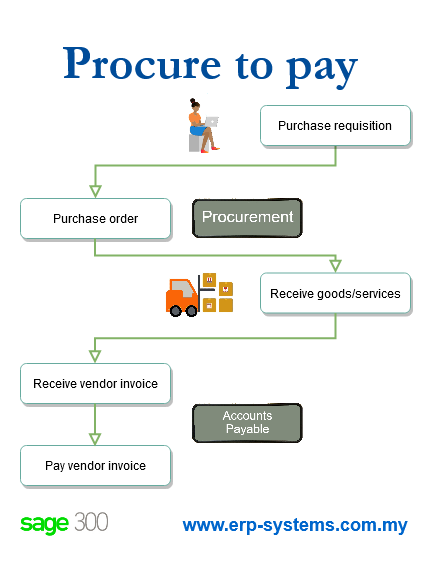What is Procure to pay?
Procure to pay is a term used to describe the end to end process of purchasing goods or services.
Wikipedia defines it as:
Procure-to-pay systems are designed to provide organizations with control and visibility over the entire life-cycle of a transaction, providing full insight into cash-flow and financial commitments.
Most of the companies using these systems look for a centralization of their procurement department, or to set up a shared services organization for the same purpose.
Purchase Requisition
It usually starts with a purchase requisition where someone in the organisation requests for the purchase of something.
A purchase requisition or PR is much more than just a document from an employee making a request.
It initiates a process that involves checking whether this request is necessary and has been budgeted for.
More importantly, does the business have sufficient cash to purchase it?
A PR will go through an approval process involving the head of department where it originated and possibly others higher up in the chain of management.

Purchase Order
Once a purchase requisition has been approved, it will be submitted to the purchasing or procurement department.
The task of procurement will be to source for the items requisitioned while taking into account 3 primary factors:
- get the best price advantage,
- negotiate terms of payment, and,
- ensure the vendor’s reliability.
Receiving of items
If it is a physical product, then warehouse will need to receive it. On the other hand, if it is a service rendered, someone needs to acknowledge that the service was rendered.
In both cases, it needs to be certified that the goods or services are according to the specifications that were requested as well as are in good order.
Receiving of vendor invoice
The next step in the procure to pay process is when accounts payable receives the vendor invoice.
They need to verify that the invoice received was for goods or services that were authorised and consequently delivered or rendered satisfactorily.
Payment of vendor invoice
The final step is payment of the vendor invoice on a timely basis.
This should take into account any discounts for early payment and ensure that this is taken advantage of.
Paying vendors on a timely basis ensures that you build and maintain a healthy relationship with them.
It gives you room to negotiate better prices, as well as timely delivery of goods and services.
Can this be done in Sage 300?
Absolutely!
Sage 300 can be setup for Purchasing and Payables Workflow to make the entire process seamless.
Working remotely
If you are working in the office, the process might be to print out the relevant documents at each stage and send it to the relevant persons for authorisation and further action.
Having to work remotely, away from the office and your colleagues, this presents a challenge.
Can Sage 300 be configured to do this digitally during this current pandemic where most of us are required to work from home?
The answer is yes.
You can configure Sage 300 to control the process and keep track of who approved the purchase requisition, who issued the purchase order, and so on.
These records of who created and who approved cannot be deleted or altered and offer a permanent audit trail.
These workflows can also be configured to send out an email to the person in the next step of the process. That person can then log into Sage 300 and do the necessary task.
Going digital
This not only helps move the process along seamlessly while we are unable to physically be at the office, but also helps with going digital, avoiding the need to print documents.
Each document can be printed to pdf, stored on a shared drive accessible to anyone with the necessary permissions, and linked to the relevant record in Sage 300.
This would mean you can view the related documents directly from inside Sage 300 while reviewing the transaction in question.
Articles
- As a business grows
- Is your accounting software doing enough?
- Managing inventory
- Key benefits of having the right solution to inventory management
- Unified solutions for better management
- Collaborate internally
- Multi Company Management
- Sage Reveals Malaysian Businesses Incur RM56.6 Billion Losses In Productivity A Year
- Mitigating Supply Chain Disruption
- Inventory costing methods
- Sage Wins Two Frost & Sullivan Asia Pacific Awards
- Going digital
- What is an ERP system?
- Covid 19 Surviving the coronavirus crisis
- Covid 19 pandemic – Lessons we have learnt

